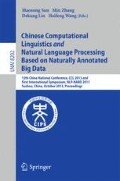Abstract
In Chinese patent texts, prepositional phrases(PP) are quite long with complicated structures. The correct identification of PP is very important for sentences parsing and reordering in machine translation. However, existing statistical and rule-based methods perform poorly in identifying these phrases because of their unobvious boundaries and special structures. Therefore, we present a method based on semantic analysis. Chinese prepositions are divided into two categories due to their semantic functions, and more contextual features are employed to identify the phrase boundaries and syntax levels. After integrating into a patent MT system, our method has effectively improved the parsing result of source language.
Access this chapter
Tax calculation will be finalised at checkout
Purchases are for personal use only
Preview
Unable to display preview. Download preview PDF.
References
Jin, Y., Liu, Z.: Improving Chinese-English Patent Machine Translation Using Sentence Segmentation. In: 7th International Conference on Natural Language Processing and Knowledge Engineering, Tokushima, pp. 620–625 (2011)
Gan, J., Huang, D.: Automatic Identification of Chinese Prepositional Phrase. Chinese Information 19, 17–23 (2005) (in Chinese)
Yin, L., Yao, T., Zhang, D., Li, F.: A Hybrid Approach of Chinese Syntactic and Semantic Analysis. Chinese Information 04, 45–51 (2002) (in Chinese)
Yu, J.: The Automatic Identification of Chinese Prepositional Phrase based on Maximum Entropy. Dalian University of Technology (2006) (in Chinese)
Lu, C., Xu, H., Wang, Y.: Research on the Identification of Chinese Prepositional Phrase based on Semantic Analysis. Computers and Telecommunications 03, 46–48 (2012) (in Chinese)
Palmer, M., Gildea, D., Kingsbury, P.: The Proposition Bank: An Annotated Corpus of Semantic Roles. Computational Linguistics 31, 71–106 (2005)
Gildea, D., Palmer, M.: The Necessity of Parsing for Predicate Argument Recognition. In: Proceedings of the 40th Meeting of the Association for Computational Linguistics, Philadelphia, pp. 239–246 (2002)
Marcus, M., Kim, G., Marcinkiewicz, M.A., MacIntyre, R., Bies, A., Ferguson, M., Schasberger, B.: The Penn Treebank: annotating predicate argument structure. In: Proceedings of the Workshop on Human Language Technology, Plainsboro, pp. 114–119 (1994)
Wang, D.: Chinese to English automatic patent machine translation at SIPO. World Patent Information 31, 137–139 (2009)
Papineni, K., Roukos, S., Ward, T., Zhu, W.: BLEU: a Method for Automatic Evaluation of Machine Translation. Technical Report RC22176 (W0109-022), IBM Research Report
Author information
Authors and Affiliations
Editor information
Editors and Affiliations
Rights and permissions
Copyright information
© 2013 Springer-Verlag Berlin Heidelberg
About this paper
Cite this paper
Hu, R., Zhu, Y., Jin, Y. (2013). Semantic Analysis of Chinese Prepositional Phrases for Patent Machine Translation. In: Sun, M., Zhang, M., Lin, D., Wang, H. (eds) Chinese Computational Linguistics and Natural Language Processing Based on Naturally Annotated Big Data. NLP-NABD CCL 2013 2013. Lecture Notes in Computer Science(), vol 8202. Springer, Berlin, Heidelberg. https://doi.org/10.1007/978-3-642-41491-6_31
Download citation
DOI: https://doi.org/10.1007/978-3-642-41491-6_31
Publisher Name: Springer, Berlin, Heidelberg
Print ISBN: 978-3-642-41490-9
Online ISBN: 978-3-642-41491-6
eBook Packages: Computer ScienceComputer Science (R0)

